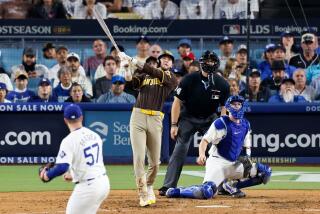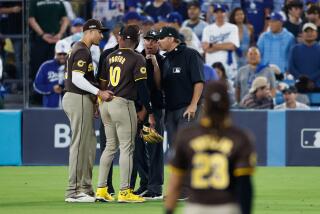Unruly Crowds: a Problem That Is Snowballing
It all began innocently enough with card stunts and pep rallies. Then came cheerleaders and mascots and fight songs.
There was never any evidence that cheerleaders cared about the game. They had their backs to it most of the day. They ere just girls who wanted to show their legs or attract Hollywood talent scouts.
The bands playing the fight songs cared even less. They were there for the halftime show. They couldnât wait till those clumsy athletes got through cluttering up the field.
Baseball disdained organized cheerleading. Baseball rooting took the form of derision. Don Rickles is the patron saint of the bleacher fan. âShow us what yer made of, Hack! Strike out again!â
But soon a new phrase crept into the lexicography, the 10th man. The 10th man was an ugly mob, an unruly rooting section not of leggy ladies in leotards but beered-up hard-hats who wanted the home team to win and would throw beer cans, sometimes full ones, at the opposition if it would help. Their intimidation of the opposition was harsh, vocal and, sometimes, physical.
The Establishment thought it was wildly funny when a burly fan jumped out of the stands once at Ebbets Field and assaulted umpire George Magerkurth. The photographs of the day show uniformed security police standing to one side, watching in amusement. They were a little more sobered when a bleacher assault on Ducky Medwick forced his removal from the 1934 World Series, but the notion prevailed--boys will be boys.
Thatâs what they said about Hitlerâs Storm Troopers, at first.
The philosophy of sports in America is that the audience is sacred. The customer is always right. The spectators paid their money; they have a right to abuse the performers. I mean, Judge Landis removed Medwick, right? He didnât remove the left-field bleachers.
Audience participation always had a strong element of the comical in it. A drunk came out of the stands once to tackle Tom Harmon on his way to a touchdown in Berkeley? Haw! A player on the bench came off it to tackle Riceâs Dicky Moegle on his way to the end zone? Heh-heh.
The term home-court advantage began to slip into the vocabulary of the game. In basketball,
it meant nothing more nor less than the timidity of the referees when faced with a hostile mass practically sitting on their necks, or the presence of a hostile owner glaring at their barbarous indifference to his need to win and making a mental note to recommend their summary firing at the next league meeting. The home-court crowd didnât intimidate the visiting players, it intimidated the visiting officials.
Los Angeles crowds were always a disappointment to students of mob psychology as an aid to victory. They went home in the seventh inning in baseball and they played with beach balls the other six. They concentrated on the hot dogs and the tailgate picnics in football.
Even at the race track, they were only half-involved. In New York, they yelled: âDonât die now, ya dog!â In L. A., they pleaded: âPlease, baby, only one more furlong!â
The term laid-back was coined to describe the commitment of the L.A. fan.
Other venues were not so contemplative. With the advent of domed stadiums, the decibel level, went, so to speak, through the roof--or, more accurately, as far as the roof and back down to multiply itself. But even before those, the cheering at Notre Dame Stadium got so ear-splitting, even in the press box, that a rule was adopted in all press boxes, football and baseball, coast to coast, that all cheering was banned under threat of expulsion.
Seattle, with a concrete dome on its facility, raised crowd noise to a high and unholy art. The Kingdome is recognized far and wide as a place where noise has to be written into the game plan. Changing plays at the line of scrimmage, a necessary ingredient in the attack of a quarterback anywhere else, is totally ruled out in Seattle.
The situation has gotten so bad that the hallowed NFL dictum, âYou canât penalize the crowd,â may have to be reviewed at the next league rules meeting.
Whatever they decide, there should be no equivocating in the matter of fan abuse or debris directly affecting the outcome of a game.
We all saw the disgraceful episode in Denver the other night when a well-aimed snowball crashed into the middle of a field-goal formation by the San Francisco 49ers. At the precise instant the ball was snapped for what would have been a decisive field goal, the missile exploded at the hands of the holder, Matt Cavanaugh. Distracted, he muffed the hold, and the field goal was missed.
At the very least, San Francisco should have been awarded the field goal. I mean, when any other intruder shows on the field to interrupt a score, the interference is disallowed. The touchdown counts.
The sway of a referee, umpire or other official of a sporting event should be total. Anything that affects the conduct of the game, whether it be by athlete or spectator, should be subject to his authority. If a man interferes with a fielder making a catch, the batter should be out. If a fan interferes with a base hit rolling in foul territory, donât make it a ground-rule double, make it a home run.
And if a fan throws a snowball in the middle of a field-goal try, make that kick good. I mean, whatâs next? A hand grenade?
And if the crowdâs noise maliciously interferes with the ability of a player to call his signals, pick up the ball and keep marching on the home team till they shut up. Or the visitors score, which always shuts them up.
Itâs not cheerleading when it alters the outcome of the game and negates fair play. Itâs hooliganism.
They put moats around athletic fields in South America. We may have to go them one better. We may have to put in glassed-off, sound-proofed partitions, too. Either that, or stop calling it sport.
More to Read
Go beyond the scoreboard
Get the latest on L.A.'s teams in the daily Sports Report newsletter.
You may occasionally receive promotional content from the Los Angeles Times.










